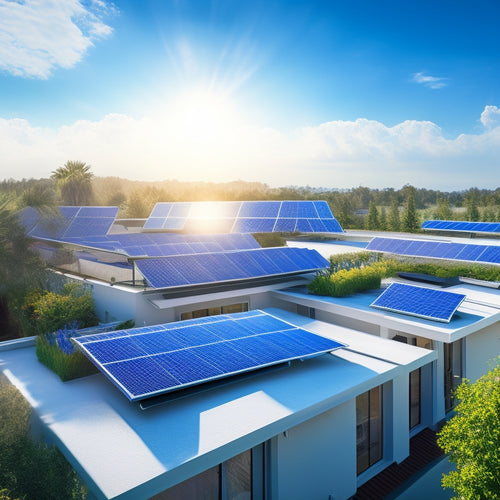
Smart Route Planning for Sustainable Transportation
Share
By adopting smart route planning strategies, you can greatly reduce the environmental impact of your transportation operations. Electric vehicle route optimization, real-time traffic pattern analysis, and dynamic route adjustments can minimize energy consumption and congestion. Energy efficiency route planning and vehicle-to-grid energy sharing also play key roles in promoting sustainability. Additionally, optimizing charging station stops and reducing greenhouse gas emissions through carbon pricing can further support a more sustainable transportation system. As you explore these innovative solutions, you'll uncover even more opportunities to refine your approach and drive meaningful change.
Key Takeaways
• Smart route planning considers electric vehicles' limited range and charging requirements to ensure efficient and sustainable transportation.
• Energy-efficient routes are identified by assessing battery durability and minimizing strain on the vehicle's battery.
• Real-time traffic pattern analysis and dynamic route adjustment systems help reduce congestion and emissions in sustainable transportation.
• Optimizing traffic signal timing and route planning can maximize energy efficiency and reduce fuel consumption for greenhouse gas emission reduction.
• Vehicle autonomy and bidirectional energy exchange enable smart route planning to prioritize energy efficiency and reduce strain on the grid.
Electric Vehicle Route Optimization
When planning routes for electric vehicles, you must consider the limited range and charging requirements to minimize downtime and reduce emissions. As you optimize routes, you'll want to prioritize Vehicle Autonomy, ensuring your electric vehicle can travel the most efficient route while maintaining a safe battery level. This is essential, as battery depletion can lead to extended downtime and increased emissions from towing or rescue services.
To achieve this, you'll need to assess the Battery Durability of your electric vehicle, taking into account factors like battery health, capacity, and charging speed. By doing so, you can identify the most energy-efficient routes, reducing the need for frequent recharging and minimizing the strain on your vehicle's battery.
Real-Time Traffic Pattern Analysis
As you explore real-time traffic pattern analysis, you'll need to pinpoint traffic congestion hotspots, leveraging real-time data analytics to identify areas where traffic flow is compromised.
By analyzing this data, you can develop pattern recognition systems that detect and respond to emerging traffic patterns.
This integrated approach enables you to optimize route planning in response to shifting traffic conditions, ultimately reducing congestion and promoting sustainable transportation.
Traffic Congestion Identification
Real-time traffic pattern analysis enables you to pinpoint traffic congestion hotspots by scrutinizing massive amounts of traffic data, including speed, volume, and occupancy rates. This analysis helps you identify areas where traffic flow is disrupted, allowing you to optimize traffic signalization to alleviate congestion. By adjusting signal timings, you can reduce congestion and decrease travel times.
Additionally, congestion pricing strategies can be implemented to discourage travel during peak hours, further reducing congestion. This approach involves charging tolls or fees to drivers who enter congested areas, encouraging them to explore alternative routes or modes of transportation.
Real-Time Data Analytics
You can leverage advanced data analytics to dissect real-time traffic patterns, extracting insights from the vast amounts of data generated by sensors, cameras, and other sources to uncover hidden trends and correlations that inform smart route planning.
By analyzing real-time traffic data, you can identify patterns that would be impossible to discern through manual observation. This enables you to optimize route planning, reducing congestion and minimizing travel times.
Predictive modeling plays an essential role in real-time data analytics, allowing you to forecast traffic conditions and adjust your route planning accordingly. By integrating data visualization tools, you can represent complex traffic data in a clear and actionable manner, facilitating data-driven decision-making.
With real-time data analytics, you can respond promptly to changes in traffic conditions, rerouting traffic to minimize congestion and reduce emissions. By harnessing the power of advanced data analytics, you can create a more sustainable and efficient transportation system.
Pattern Recognition Systems
By deploying advanced pattern recognition systems, traffic managers can break down complex traffic patterns into identifiable components, uncovering hidden relationships between traffic volume, speed, and incident data. This allows you to identify patterns that may not be immediately apparent, enabling you to make more informed decisions about traffic management.
Here are three key benefits of pattern recognition systems in real-time traffic pattern analysis:
-
Improved incident detection: By analyzing real-time data, pattern recognition systems can quickly identify anomalies in traffic patterns, allowing for rapid response to incidents and minimizing their impact on traffic flow.
-
Optimized traffic signal control: By recognizing patterns in traffic volume and speed, you can optimize traffic signal control to minimize congestion and reduce travel times.
-
Enhanced predictive analytics: Pattern recognition systems can be used to develop predictive models that forecast traffic patterns, enabling you to proactively manage traffic and reduce congestion.
Energy Efficiency Route Planning
Maximizing energy consumption through route planning is essential, as it directly impacts the environmental sustainability and operational costs of transportation systems, with even a 1% improvement in route efficiency capable of yielding significant reductions in greenhouse gas emissions.
As you navigate through the complexities of route planning, you'll realize that fuel consumption plays an important role in energy efficiency. By optimizing routes, you can reduce fuel consumption, which in turn reduces carbon emissions. This is particularly critical for transportation systems, as they're significant contributors to greenhouse gas emissions.
When it comes to energy efficiency route planning, route durability is an important consideration. A durable route is one that minimizes fuel consumption while ensuring the safety and reliability of the transportation system. By analyzing route durability, you can identify areas of improvement, such as optimizing traffic signal timing or adjusting vehicle speeds.
Dynamic Route Adjustment System
Implementing a dynamic route adjustment system allows transportation operators to respond to real-time changes in traffic patterns, weather conditions, and other external factors that impact route efficiency. This system enables you to adapt to unexpected disruptions, guaranteeing that your routes remain optimized and efficient.
With dynamic route adjustment, you can:
-
Re-route around congested areas in real-time, minimizing delays and reducing emissions.
-
Adjust to changing weather conditions, such as road closures or flooding, to ensure safe and efficient transportation.
-
Respond to unexpected events, like accidents or roadwork, to maintain route flexibility and minimize disruptions.
Vehicle-to-Grid Energy Sharing
When exploring Vehicle-to-Grid Energy Sharing, it's crucial to take into account the role of grid energy storage in optimizing energy flow.
You'll need to evaluate how electric vehicles can function as energy storage devices, feeding electricity back into the grid when not in use.
Grid Energy Storage
You can tap into the excess energy stored in your electric vehicle's battery through Vehicle-to-Grid (V2G) technology, which enables your car to act as a power source when it's not in use. This innovative approach to energy storage not only minimizes energy waste but also increases grid resilience.
With V2G, you can harvest excess energy generated by your vehicle and feed it back into the grid, providing a clean and sustainable source of power.
Here are three key benefits of V2G technology:
-
Increased Grid Resilience: By leveraging the collective energy storage capacity of electric vehicles, V2G technology can help stabilize the grid during peak hours or in times of high demand.
-
Energy Harvesting: Your vehicle can act as a mobile energy harvesting device, capturing and storing excess energy generated by regenerative braking or other means.
-
Reduced Energy Waste: V2G technology ensures that the energy stored in your vehicle's battery is utilized efficiently, decreasing waste and promoting a more sustainable energy ecosystem.
Optimizing Energy Flow
By leveraging V2G technology, you can optimize energy flow by intelligently managing the bidirectional energy exchange between your electric vehicle and the grid, guaranteeing a more efficient and sustainable energy ecosystem. This innovative approach enables your vehicle to act as an energy storage device, feeding energy back into the grid when not in use. As a result, you can reduce strain on the grid during peak hours, stabilize the energy supply, and even generate revenue through energy harvesting. By doing so, you'll be contributing to a more resilient and efficient power distribution system.
When your vehicle is connected to the grid, V2G technology allows you to control the flow of energy in real-time, responding to changes in demand and supply. This dynamic energy management system ensures that energy is distributed efficiently, reducing waste and minimizing the strain on the grid.
With optimized energy flow, you can enjoy a seamless and sustainable transportation experience, while also supporting a more sustainable energy future.
Greenhouse Gas Emission Reduction
Reducing greenhouse gas emissions from transportation requires integrating low-carbon fuels, optimizing routes, and promoting modal shifts, all of which can be achieved through smart route planning. As you explore ways to reduce your carbon footprint, you'll find that smart route planning is a vital step towards climate neutrality.
Here are three key strategies to explore:
-
Shift to electric vehicles:
Shifting to electric vehicles can greatly reduce greenhouse gas emissions. Smart route planning can help you optimize your fleet's energy consumption and identify opportunities to switch to low-carbon fuels. -
Enhance your routes:
By analyzing traffic patterns, road conditions, and other factors, you can reduce fuel consumption and lower emissions. Smart route planning can help you find the most efficient routes and reduce unnecessary detours. -
Implement carbon pricing:
Assigning a cost to carbon emissions can incentivize sustainable behaviors and encourage a shift towards low-carbon transportation options. Smart route planning can help you calculate and manage your carbon footprint, making it easier to implement carbon pricing strategies.
Optimizing Charging Station Stops
Optimizing charging station stops is essential for electric vehicle fleet operators, as it can greatly reduce downtime and increase the overall efficiency of their operations. By strategically placing charging stations along routes, you can minimize the time spent waiting for vehicles to recharge, allowing for more efficient use of resources. Effective charging station design is vital in this process, as it can greatly impact the overall efficiency of your operations.
| Charging Station Location | Urban Planning Strategy | Benefits |
|---|---|---|
| City Centers | Mixed-use development | Increased foot traffic, reduced congestion |
| Highway Rest Stops | Corridor-focused development | Convenient for long-distance travelers, reduced fatigue |
| Public Parking Garages | Infill development | Increased accessibility, reduced land use |
| Commercial Areas | Transit-oriented development | Increased economic activity, reduced congestion |
| Residential Neighborhoods | Pedestrian-friendly design | Increased safety, reduced noise pollution |
Frequently Asked Questions
Can Smart Route Planning Reduce Traffic Congestion in Urban Areas?
You explore how traffic patterns and urban dynamics intertwine, and yes, smart route planning can alleviate congestion in urban areas by optimizing routes, reducing travel times, and decreasing the number of vehicles on the road.
Are Electric Vehicles More Expensive Than Traditional Gas-Powered Cars?
You'll find that electric vehicles are often pricier than traditional gas-powered cars due to higher battery costs, but as charging infrastructure expands, prices are decreasing, making them more competitive in the market.
How Does Route Planning Impact the Environment Directly?
You might be surprised to know that 25% of emissions come from transportation; when you plan your route, you're directly impacting the environment through reduced fuel consumption, lowering your carbon footprint and increasing fuel efficiency.
Can Smart Route Planning Be Used for Public Transportation Systems?
You can leverage smart route planning for public transportation systems by implementing optimized schedules and real-time updates, ensuring efficient routes and reducing congestion, which in turn benefits the environment and commuters alike.
Are There Incentives for Adopting Sustainable Transportation Methods?
You might be surprised that 75% of consumers consider the environment when making purchasing decisions. When adopting sustainable transportation methods, you can tap into government subsidies and corporate benefits, such as tax credits and reduced operational costs.
Related Posts
-

Top 10 Tips for Buying Car Accessories Online
When purchasing car accessories online, you should take proactive steps to avoid low-quality or incompatible products...
-

Safety First: Why Seniors Need Advanced Vehicle Features
As you get behind the wheel, you're likely unaware that seniors are 16% more likely to be involved in a fatal car cra...
-

Best Solar Panel Options for Maximum Energy Savings
You can maximize your energy savings with solar panels that boast efficiency ratings above 20%, paired with extensive...


